I have been, or can be if you click on a link and make a purchase, compensated via a cash payment, gift, or something else of value for writing this post. As an Amazon Associate, I earn from qualifying purchases. Please read my full Affiliate Disclosure for more information.
Ever feel like your bedroom could use a little more harmony and positive energy? That’s where feng shui comes in! This ancient Chinese art of arrangement is gaining popularity worldwide because it promises to transform your space into a sanctuary of peace, balance, and good vibes. With its simple yet powerful principles, feng shui helps create environments that support restful sleep, boost happiness, and enhance overall well-being.
In this article, you’ll discover a variety of inspiring feng shui bedroom layout ideas that anyone can try—whether you’re working with a small space, aiming for a cozy retreat, or seeking a modern, clutter-free look. From clever furniture placement tips to decorative accents that promote positive energy, these ideas will help you craft a bedroom that feels just right. Get ready to transform your space into a harmonious haven where energy flows freely and good fortune follows!
1. Positioning the Bed for Optimal Flow and Balance
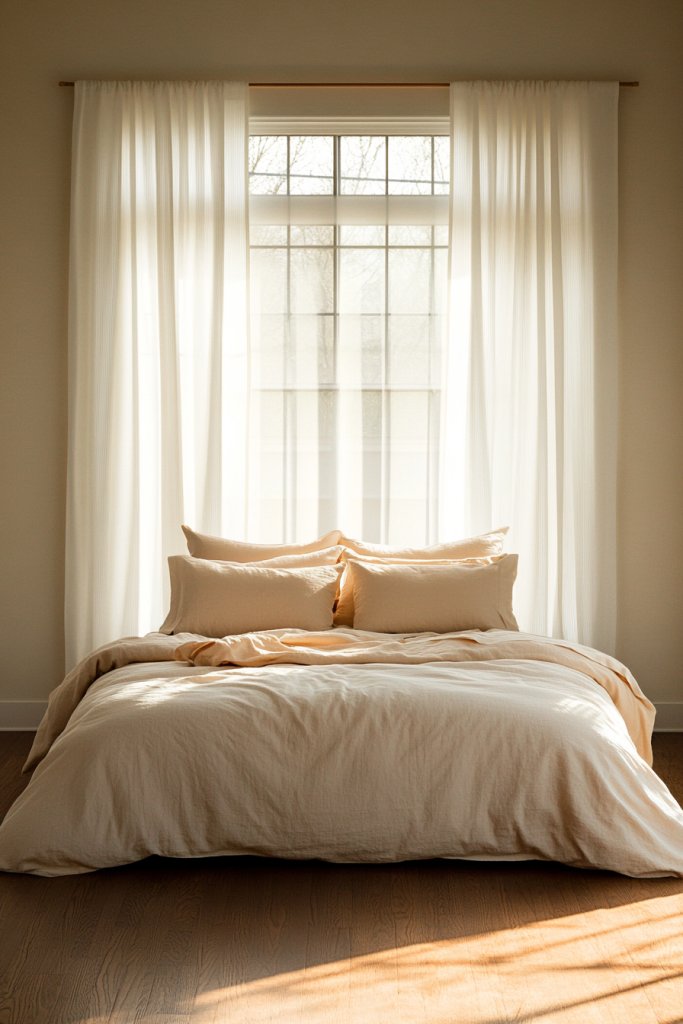
Ever feel like your bedroom’s energy is stuck in a rut, leaving you restless or unfulfilled? The way you position your bed can make a huge difference in how peaceful and balanced your space feels. Many of us overlook this simple detail, but it influences sleep quality and overall harmony. Imagine waking up refreshed, feeling rooted and secure every morning.
Recommended Products to replicate this idea
| # | Preview | Product | |
|---|---|---|---|
| 1 |

|
NEW JETO Metal Bed Frame,Queen Size Bed Frame with Storage Space,Heavy Duty Sturdy Mattress... | Check Latest Price |
| # | Preview | Product | |
|---|---|---|---|
| 1 |

|
Rolanstar Headboard for Full Size Bed with Storage, 60,000 DIY Color of LED Light, Head Board... | Check Latest Price |
Picture your bed placed against a sturdy wall, centered perfectly to create a sense of stability. The headboard supports your back and lends a feeling of protection, while open space around the foot of the bed invites free energy flow. Soft natural light filters through, highlighting the symmetry and calm. The room feels grounded, with a visual balance that immediately soothes your mind.
Depending on your room layout, you might opt for a slightly off-center placement if it suits your window or closet. For smaller spaces, positioning the bed diagonally can maximize space, while larger rooms can accommodate multiple beds for family harmony. Seasonal tweaks, like adding a cozy throw or a textured headboard, enhance the feeling of security year-round. The key is customizing position to your specific needs.
Start by measuring your room and noting where natural light and doors are located. Choose a wall that offers solid support and minimal external disturbance. Avoid placing the bed directly in line with doors or windows to prevent drafts and external noise. Use a sturdy frame with a supportive headboard to anchor the bed visually and energetically. Adjust the bed’s position based on your daily routines and comfort preferences. Remember, the goal is symmetry and stability.
Add plush textiles like a soft cream throw blanket with chunky knit texture to evoke comfort. Incorporate personal mementos on bedside shelves or a decorative pillow that makes you feel secure. Use artwork or tapestries above the bed (avoiding clutter) to reinforce positive energy. The idea is to create a sanctuary that feels both safe and inviting, reflecting your personality.
Getting your bed placement right sets the tone for your entire day. When your space feels balanced, your mind relaxes, promoting restful sleep and energetic mornings. Trust your intuition—small adjustments can dramatically improve your bedroom’s vibe. Creating a harmonious environment is within your reach, and the benefits ripple through all areas of life.
2. Creating Clear Pathways with Minimal Clutter
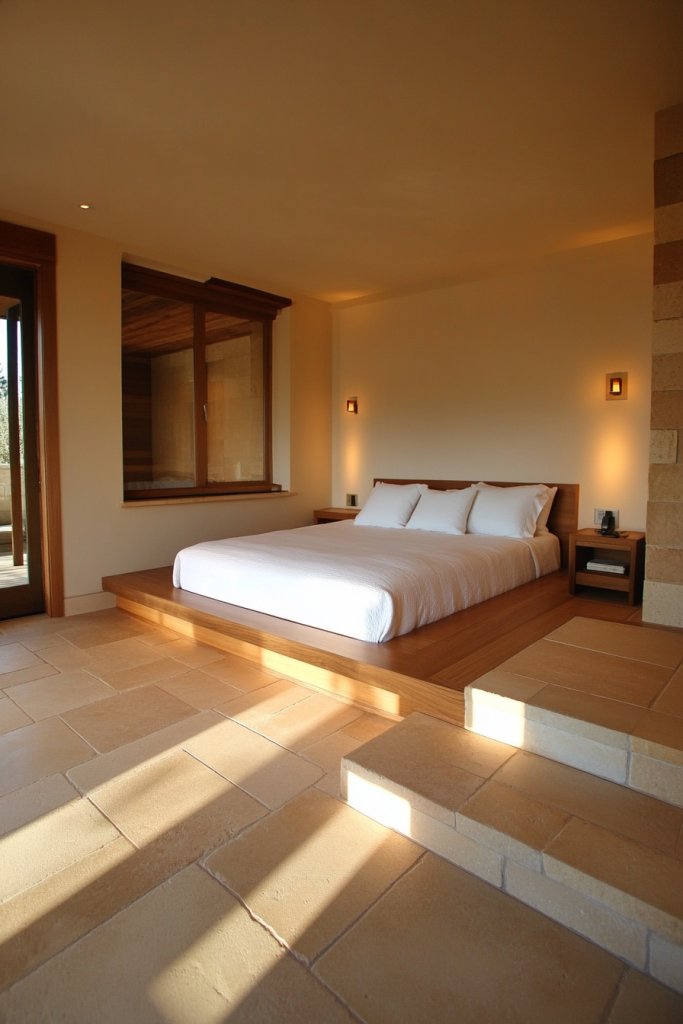
Is your bedroom feeling cramped even when it’s not? Clutter and blocked pathways disrupt the flow of energy, making you feel anxious or sluggish. Clearing a path around your furniture isn’t just about aesthetics—it’s about inviting vitality into your space. Imagine walking in and feeling an instant sense of calm and openness.
Recommended Products to replicate this idea
| # | Preview | Product | |
|---|---|---|---|
| 1 |

|
Criusia 4 Pack Large Storage Baskets for Shelves | Fabric Closet Organizers and Storage Bins with... | Check Latest Price |
| # | Preview | Product | |
|---|---|---|---|
| 1 |

|
BAYKA Floating Shelves for Wall, Wall Mounted Rustic Wood Shelves for Bathroom, Bedroom, Living... | Check Latest Price |
Envision a room where the walking areas are free from obstacles, with a soft rug guiding your steps. The furniture is arranged to allow smooth movement without sharp corners jutting into walkways. Light filters around the room, bouncing off clean surfaces, emphasizing the openness. You feel a gentle breeze of energy flowing freely, making the space feel alive and welcoming.
In small rooms, opt for multi-functional pieces that double as storage, keeping surfaces clear. Use sleek, low-profile furniture to maximize visible space. For seasonal changes, swap bulky items for streamlined alternatives. Even in larger rooms, maintaining clear pathways encourages better circulation and relaxation. Think of it as creating an invisible highway for good vibes.
Begin by decluttering daily essentials from nightstands and floors. Rearrange furniture to create at least 18-24 inches of walking space around beds and dressers. Use vertical storage options like wall-mounted shelves, avoiding stacking or piling on the floor. Keep pathways unobstructed by cords, shoes, or unnecessary furniture. Regularly reassess your layout to prevent clutter from creeping back.
Introduce decorative storage solutions like woven baskets or fabric bins that hide clutter while adding texture. Use soft, calming colors on walls and furniture to keep the space feeling light and airy. Incorporate tactile textiles—like a plush throw or a textured cushion—to make movement feel inviting. Small touches like a decorative tray to corral nighttime essentials also help maintain order.
A clutter-free room isn’t just prettier—it actively boosts your mood and energy. When pathways are clear, you move through your space with ease, reducing stress. Remember, a tidy room is a reflection of a tidy mind. Start small, and watch how your bedroom transforms into a sanctuary of peaceful flow.
3. Incorporating Soft, Diffused Lighting for Calm Atmosphere
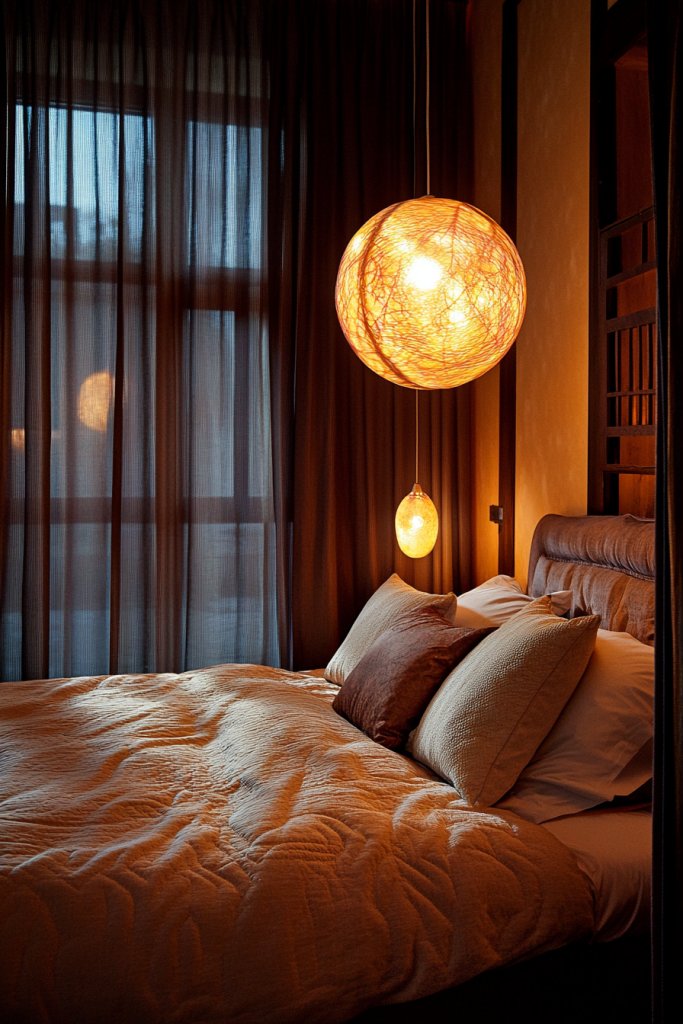
Ever noticed how harsh lighting can turn a peaceful bedroom into a clinical space? Bright overhead fixtures may wake you up instead of helping you relax. Soft, diffused lighting creates a warm cocoon that promotes calm and restful sleep. Imagine winding down under gentle illumination, feeling the tension melt away.
Recommended Products to replicate this idea
| # | Preview | Product | |
|---|---|---|---|
| 1 |

|
Yikuneng Dimmable LED Floor Lamp, Super Bright Reading Lamps Floor Standing lamp with Remote &... | Check Latest Price |
| # | Preview | Product | |
|---|---|---|---|
| 1 |

|
Small Table Lamp for Bedroom - Bedside Lamps for Nightstand, Minimalist Night Stand Light Lamp... | Check Latest Price |
Picture bedside lamps with fabric shades casting a warm glow, or string lights woven through textured fabrics or behind headboards. Candles (real or flameless) flicker softly, adding a calming ambiance. The room is bathed in a gentle, even light that avoids harsh shadows, creating a cozy retreat. This layered lighting setup invites you to unwind and relax.
Use dimmable fixtures to control brightness depending on the time of day or mood. Incorporate wall sconces or LED strip lights hidden behind architectural features to add depth without direct glare. For seasonal coziness, swap out cool bulbs for warmer ones. Different rooms may benefit from different lighting setups—think softer lights for the bedroom, brighter for dressing areas.
Start by replacing bright ceiling fixtures with dimmable options or adding multiple layers of lighting. Use lamps with fabric or textured shades for diffusion, avoiding direct, unfiltered bulbs. Install dimmer switches on main fixtures for flexible control. Position lights to highlight architectural features or create pools of soft light around seating or reading areas. Consider using candles or flameless LEDs for ambiance without safety concerns.
Add scented candles or diffusers nearby (just not directly in the light) to combine fragrance with ambiance. Choose lamps with textured or patterned shades that complement your decor. Incorporate adjustable lighting zones to create different moods—cozy, romantic, or energizing—whenever needed. Personal touches like a vintage lantern or a unique pendant can elevate your lighting design.
Layered, soft lighting transforms your bedroom into a sanctuary. It signals your brain that it’s time to wind down and relax, improving sleep quality. Experiment with different setups until you find your perfect glow. The right lighting makes all the difference—it’s a simple change with profound effects.
4. Using Symmetry to Promote Balance and Harmony
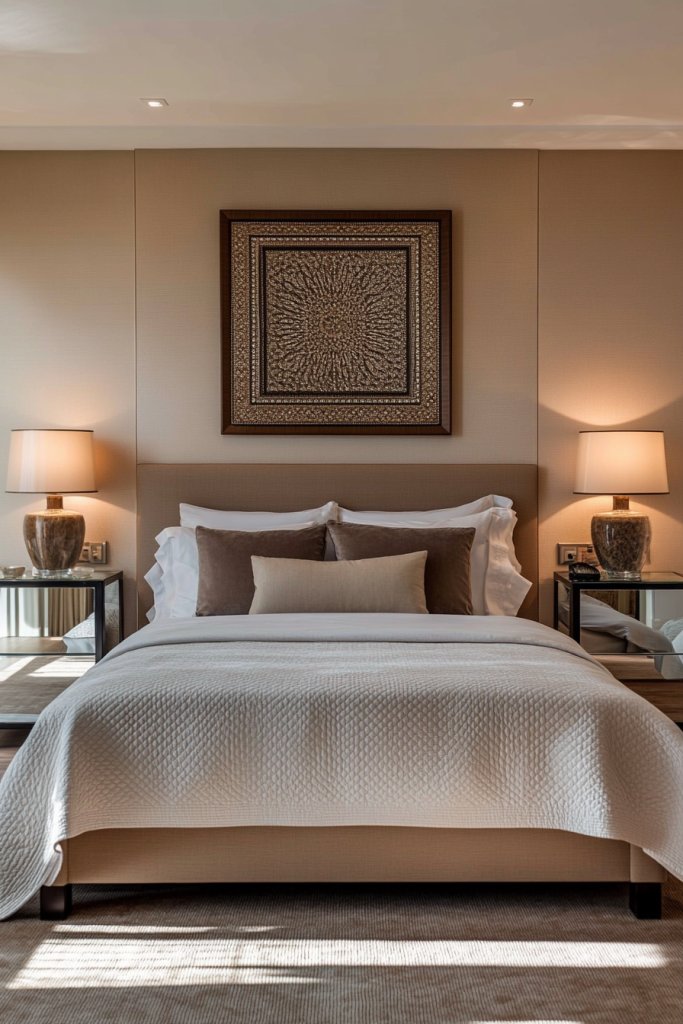
Does your bedroom feel off-balance or chaotic? Asymmetry can subconsciously cause stress and unease. Symmetry creates a visual harmony that promotes calm and focus. Think of it as the visual equivalent of a deep, slow breath—grounding and centering.
Imagine matching nightstands on each side of the bed, with identical lamps casting warm light. The bed itself is centered, with coordinated bedding and pillows. Symmetrical artwork or decor on either side enhances the sense of stability. The overall effect is a peaceful, orderly space that invites relaxation and restful sleep.
You don’t have to mirror everything perfectly—subtle asymmetries, like different textures or shades, can still evoke harmony. For small rooms, balancing furniture and accessories on each side maintains equilibrium. Seasonal decor can be swapped in, ensuring balance remains intact. For shared bedrooms, symmetry helps establish personal zones within a shared space.
Start by arranging matching bedside tables and lamps on either side of your bed. Use coordinated bedding and cushions for visual balance. Hang artwork or decorative panels at equal heights and distances. Keep the space clutter-free to reinforce symmetry’s calming effect. When in doubt, step back and assess the overall balance—adjust as needed to create a cohesive look. Consistency is key.
Incorporate textured textiles or subtle color variations that mirror each side, adding depth without disrupting harmony. Use matching storage baskets or decorative accents that tie the sides together. Personalize each side with meaningful objects, but keep the overall aesthetic balanced. This approach enhances comfort while maintaining visual serenity.
Symmetry isn’t about perfection—it’s about creating a sense of order that your subconscious recognizes as safe. When your space feels balanced, your mind relaxes, and sleep improves. Trust that simple visual harmony can transform your bedroom into a true sanctuary. Small adjustments make a big difference.
5. Positioning the Bed Away from Windows for Restful Sleep
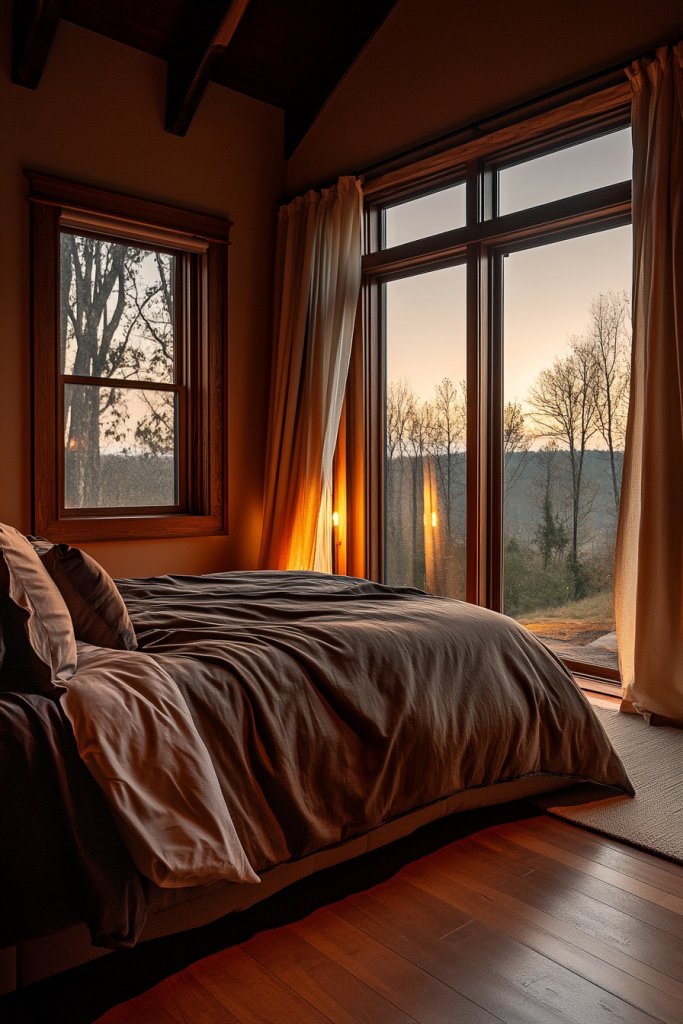
Ever wake up feeling restless, even after a full night’s sleep? Window drafts, external noise, and light can interfere with deep rest. Moving your bed away from windows minimizes these disturbances, helping you wake up refreshed. Creating a sleep-friendly zone is easier than you think—and totally worth it.
Recommended Products to replicate this idea
| # | Preview | Product | |
|---|---|---|---|
| 1 |

|
Rolanstar Headboard for Full Size Bed with Storage, 60,000 DIY Color of LED Light, Head Board... | Check Latest Price |
| # | Preview | Product | |
|---|---|---|---|
| 1 |

|
NICETOWN Halloween Pitch Black Solid Thermal Insulated Grommet Blackout Curtains/Drapes for... | Check Latest Price |
Think of your bed tucked away against a solid wall, shielded from the window by a sturdy headboard or a decorative screen. Soft blackout curtains or layered window treatments block light and noise, creating a cocoon of tranquility. The room exudes calm, with the bed positioned for maximum comfort and minimal external interference. The space feels secure, like your personal sanctuary.
In rooms where bed placement is limited, use room dividers or tall headboards to create a barrier from windows. For rooms with large windows, consider blackout blinds or heavy drapes that can be drawn at night. If space allows, move the bed to a corner or opposite the window for extra seclusion. Adapt your decor to maintain aesthetic harmony despite positional adjustments.
Start by assessing your room layout and identifying the optimal bed position. Use a sturdy headboard against a wall away from the window to anchor the space. Install blackout curtains or layered window treatments to block external light and sound. Avoid placing the bed directly under or next to windows to prevent drafts and external energy disturbances. Adjust furniture and decor to create a cozy, protected environment. Small changes can significantly improve sleep quality.
Add plush textiles like a thick duvet or textured blankets to deepen the feeling of security. Use decorative elements like a tapestry or an upholstered panel behind the bed to reinforce stability. Incorporate personal items that evoke peace—like a favorite soft throw or a calming scent—further enriching your sleep space. The goal is a retreat that welcomes restful, uninterrupted sleep.
Prioritizing your sleep environment pays off in better health and mood. When your bed is positioned away from external disturbances, you wake up more energized and ready to face the day. Small positional tweaks can have a big impact—trust your instincts and keep refining your space until it feels just right. Better sleep is within your reach.
6. Utilizing Natural Materials and Textures for Grounding
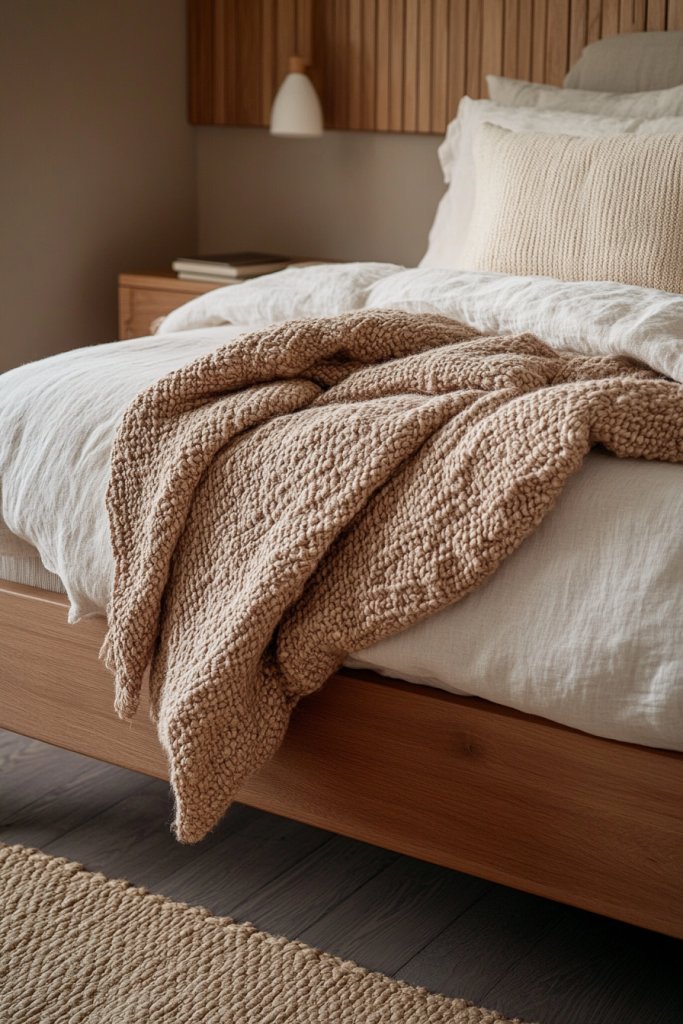
Feeling disconnected or overwhelmed in your bedroom? Incorporating natural materials and textures can ground your space and your mind. The right tactile elements foster a sense of stability and calm. Think earthy, cozy, and authentic—your bedroom should feel like a retreat from the chaos.
Recommended Products to replicate this idea
| # | Preview | Product | |
|---|---|---|---|
| 1 |

|
Mellow Naturalista Classic - 12 Inch Solid Wood Platform Bed with Wooden Slats, No Box Spring... | Check Latest Price |
| # | Preview | Product | |
|---|---|---|---|
| 1 |

|
Arcturus Military Wool Blanket - Warm, Thick, Washable - Great for Outdoors - Large 64 inches x... | Check Latest Price |
Imagine a bed with a linen duvet, layered with a wool blanket and cotton sheets—each texture inviting touch. Wooden furniture adds warmth and organic appeal, while woven baskets or jute rugs introduce tactile richness. The room’s color palette echoes nature—soft browns, creams, and muted greens—creating a soothing, earthy vibe. The overall effect is a space that feels both nurturing and invigorating.
Mix and match materials for a layered look—think a stone table paired with a soft cotton throw or a rattan headboard. For colder months, add a chunky knit blanket or faux fur accents for extra coziness. Sustainable or reclaimed materials can add a unique touch while supporting eco-conscious choices. Adapt textures to your personal comfort level and aesthetic preferences.
Start by choosing furniture made from natural wood or bamboo, emphasizing durability and sustainability. Use bedding in natural fibers like linen, cotton, or hemp, which age beautifully and breathe well. Incorporate woven or textured accessories—like a jute rug or wicker storage—to add tactile dimension. Keep surfaces free of synthetic plastics or overly processed materials. Regularly clean and care for natural elements to maintain their beauty.
Add a few handcrafted items—like a ceramic bowl or a linen pillowcase—to deepen the authentic feel. Use essential oils or natural incense to evoke the scent of the outdoors. Incorporate a textured wall covering or a woven wall hanging (avoiding strict wall art if necessary) to add visual interest. Keep your space simple but rich in natural tactile appeal.
Grounding your bedroom with natural materials connects you to the earth’s calming energies. It’s a simple yet powerful way to foster tranquility and mindfulness. Your space becomes a true sanctuary, supporting your well-being daily. Trust in the natural, authentic elements to create a balanced, rejuvenating environment.
7. Creating a Clutter-Free Nightstand for Peaceful Energy
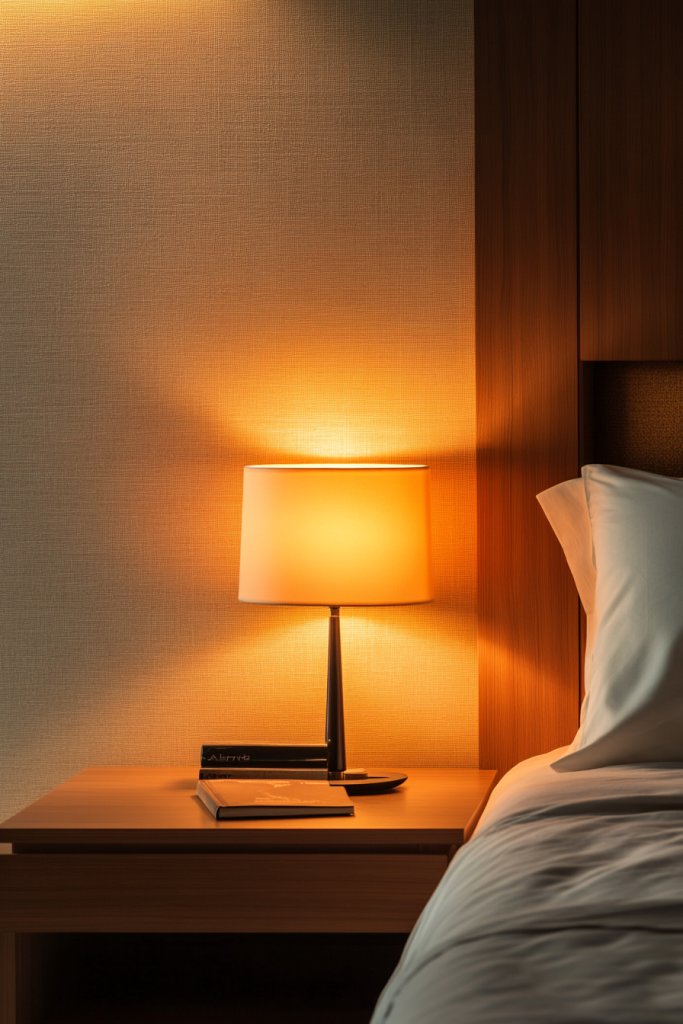
Nightstands cluttered with endless items can create a chaotic mental space before sleep. A tidy, minimal nightstand promotes calm and clarity, making your entire bedroom feel more peaceful. Imagine reaching for your essentials effortlessly and ending the day with a sense of order.
Recommended Products to replicate this idea
| # | Preview | Product | |
|---|---|---|---|
| 1 |

|
Nathan James Jackson Wall Mounted Floating Bedroom Nightstand with Storage Drawer and Modern Open... | Check Latest Price |
| # | Preview | Product | |
|---|---|---|---|
| 1 |

|
WOWBOX 25 PCS Clear Plastic Drawer Organizer Set, 4 Sizes Desk Drawer Divider Organizers and... | Check Latest Price |
Visualize a sleek nightstand with only a few carefully chosen items—perhaps a soft clock, a small candle, and a favorite book. Everything has a designated spot, and surfaces are free of excess. The surrounding space feels open and inviting, with clean lines that soothe the eye. The room exudes a sense of calm, encouraging restful nights.
Opt for floating or wall-mounted nightstands to save space and maintain openness. Use storage baskets or fabric boxes to hide clutter inside larger units. For different seasons, swap out items to keep the surface simple and relevant—like a small plant in spring or a cozy candle in winter (if not restricted). The minimalist approach works well in all room sizes.
Start by removing everything from your nightstand and sorting essentials. Keep only items you truly use daily—like a sleep mask or a small journal. Use trays or containers to organize small items, and hide chargers or cables inside drawers or behind panels. Regularly revisit the space to prevent accumulation of unnecessary items. A clear, dedicated spot for each item maintains peace.
Choose a calming color scheme for your nightstand and surrounding decor. Incorporate a textured cloth or a soft fabric underneath your essentials to add warmth. Personalize with a meaningful object, like a small sculpture or a favorite memento, kept neatly in sight. Keep the design simple but meaningful.
A clutter-free nightstand sets the tone for an organized life. It’s a small change that can significantly reduce stress and improve your sleep quality. When your space is tidy, your mind relaxes naturally. Embrace the simplicity—you deserve a peaceful retreat every night.
8. Arranging Storage Solutions to Avoid Energy Blockages
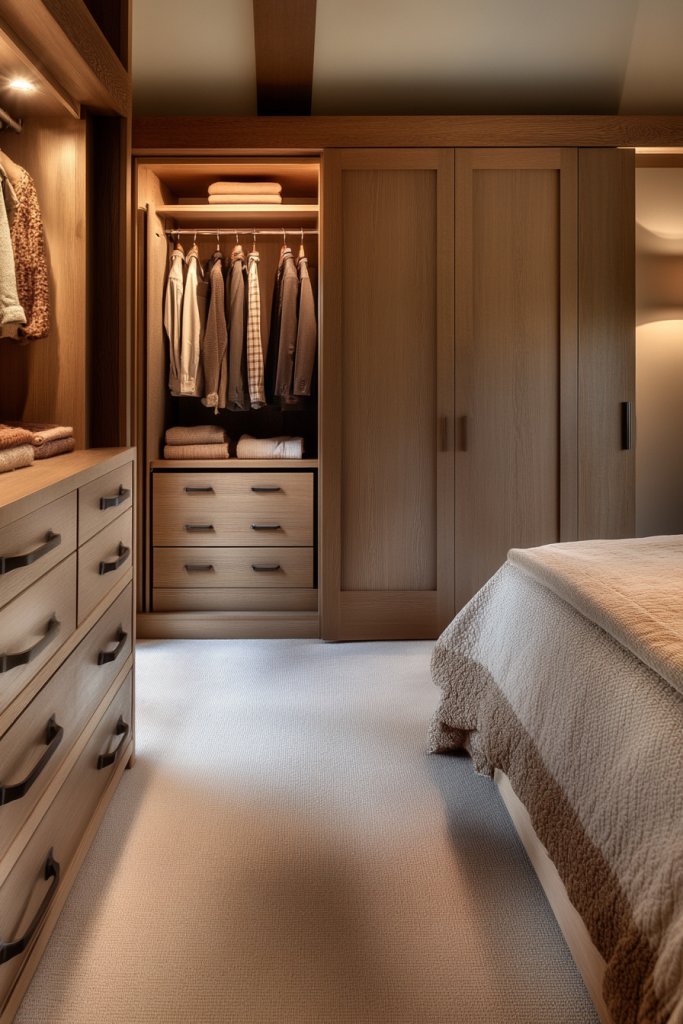
Do you feel like your bedroom energy gets stuck behind piles of clothes or overflowing drawers? Poor storage creates blockages that hinder the flow of good vibes. Organized, harmonious storage frees up space and invites positive energy. Imagine a room where everything has a place and nothing feels cramped.
Visualize sleek under-bed drawers, woven baskets on shelves, and decorative chests that double as seating. Belongings are neatly tucked away, leaving surfaces clean and unobstructed. The space feels open, with clear pathways and a sense of order. Light flows freely, bouncing off tidy surfaces, creating an inviting atmosphere.
Use multifunctional furniture—like storage beds or ottomans—to hide clutter stylishly. Incorporate baskets or bins that fit your decor theme, from boho to modern. For seasonal storage, swap items in and out to keep clutter at bay. Adapt your solutions to your room size and aesthetic preferences, always aiming for harmony.
Start by decluttering and categorizing your belongings. Invest in matching storage bins or decorative boxes that suit your decor style. Use labels for easy access and maintain a habit of tidying regularly. Maximize vertical space with wall-mounted storage, and keep seldom-used items out of sight. Regularly reassess your storage to prevent clutter accumulation. The goal is effortless access and visual calm.
Choose containers that complement your bedroom’s color palette and style. Incorporate textured or patterned storage to add visual interest. Personalize your storage with labels or decorative accents. Keep frequently used items within easy reach, and hide bulkier or seasonal items out of sight for a clean look.
Smart storage isn’t just about tidiness—it’s about creating space for positive energy to circulate. When your belongings are organized, your mind feels lighter, and sleep quality improves. Trust that a well-ordered room enhances your well-being. Small changes in storage can lead to big shifts in your bedroom’s vibe.
9. Implementing a Headboard for Stability and Support
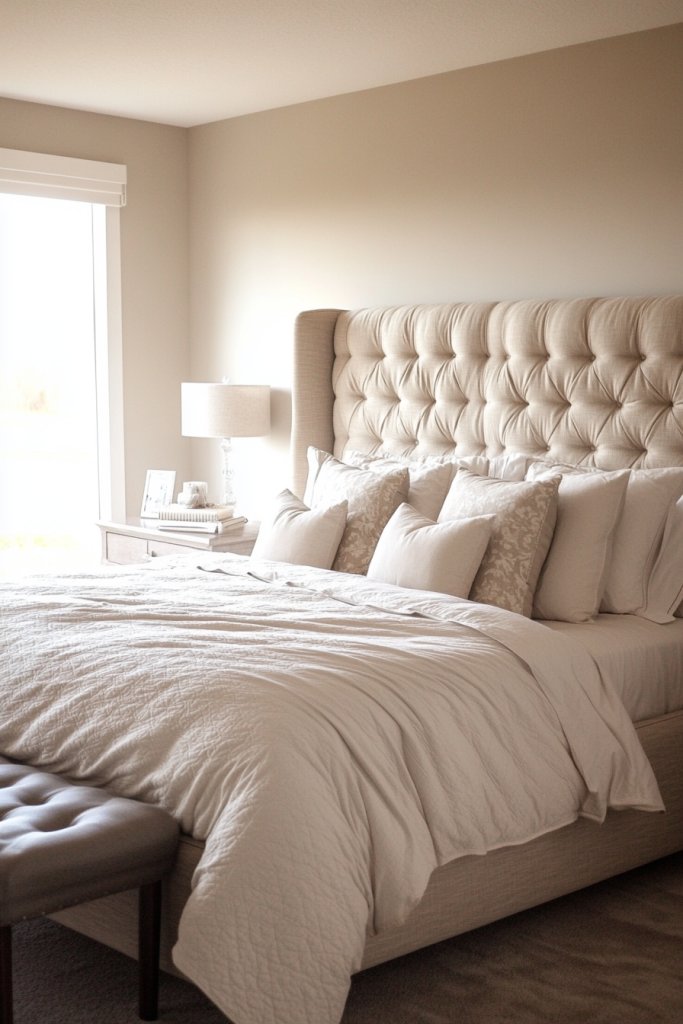
Ever notice how a room feels ungrounded without a proper headboard? It’s more than decoration—headboards symbolize support and security. Without one, the space can feel incomplete or unstable. Adding a sturdy headboard anchors your bed physically and energetically, creating a calming focal point.
Imagine a plush fabric headboard in a neutral tone, upholstered and tufted for softness. It extends the width of your bed, giving a sense of strength and protection. The surrounding walls are painted in soothing shades, complementing the headboard’s texture. The overall look is cozy, inviting, and balanced—a perfect retreat for rest.
Choose from upholstered, wooden, or metal headboards depending on your style. For a minimalist look, opt for sleek, low-profile designs; for more character, go for carved or textured options. You can also layer textiles like a padded panel behind a decorative frame for added support. Seasonal changes might include swapping covers or adding decorative pillows (avoiding restricted items). The key is creating a sense of security.
Start by selecting a sturdy, well-made headboard that fits your bed size. Mount it securely to the wall or attach it directly to your bed frame. Ensure it’s at a comfortable height for leaning or reading in bed. Complement with bedding that enhances the headboard’s style—think soft, calming fabrics. Regularly inspect mounting points for stability. This simple addition can dramatically change your bedroom’s energy.
Add a textured cover or a decorative trim to the headboard for extra visual interest. Incorporate personal objects or meaningful textiles that evoke feelings of safety and support. Use layered bedding in calming hues to reinforce the sense of security. Keep the space around the headboard tidy to maintain visual harmony.
A strong headboard not only beautifies your space but also promotes emotional stability. When you feel supported visually and physically, your sleep and relaxation improve. Trust that this simple element can be a game-changer for your bedroom’s energy. Creating a sanctuary of support is a small but powerful act.
10. Enhancing the Space with Calming Color Palette

Colors influence mood more than you realize—bright reds might energize, but they can also keep you awake. A calming color palette induces relaxation and peace, perfect for a bedroom sanctuary. Think soft blues, gentle neutrals, and muted earth tones that soothe the senses. The right hues set the tone for restful sleep and positive energy.
Recommended Products to replicate this idea
| # | Preview | Product | |
|---|---|---|---|
| 1 |

|
EVOLVE Paint & Primer: Environment-friendly, Low Sheen with One-coat Coverage for Interior &... | Check Latest Price |
| # | Preview | Product | |
|---|---|---|---|
| 1 |

|
Bedsure Queen Comforter Set - Beige Comforter Queen Size, Soft Bedding for All Seasons, Cationic... | Check Latest Price |
Envision walls painted in a serene pale blue, complemented by neutral bedding and textured textiles in sandy beige. The room feels airy and light, with subtle contrasts that add depth without overstimulation. Natural light enhances the gentle palette, making the space feel open and inviting. The overall effect is a quiet retreat that calms your mind at the end of the day.
Adjust the palette seasonally—introduce warmer tones like soft terracotta or blush in winter, and cooler shades like mint or lavender in summer. Use textiles and accessories in muted hues to reinforce tranquility. For a more vibrant touch, add subtle accents like pastel cushions or decorative throws in complementary shades. The goal is a cohesive, soothing environment.
Start by choosing paint or wallpaper in soft, calming shades. Keep furniture in neutral or matching tones to unify the space. Use textiles like linen, cotton, or silk in subdued colors for bedding and window treatments. Avoid overly bright or dark colors that disrupt the sense of calm. Layer textures carefully to add visual interest without overwhelming. Regularly reassess your color scheme to maintain harmony.
Incorporate personal favorites in your palette—perhaps a calming shade inspired by your favorite landscape or a soothing pattern. Use decorative textiles in complementary hues to add depth. Keep decor minimal and purposeful, avoiding clutter that distracts from the calming effect. Small details like a cozy throw or a textured rug can make a big difference.
Colors shape your emotional landscape—choose wisely to foster peace and positivity. When your bedroom palette supports tranquility, sleep improves naturally. Trust your instincts and experiment with shades until your space feels like your personal oasis. A harmonious color scheme is the foundation of a restful, balanced bedroom.
11. Positioning Mirrors Mindfully to Expand Space and Light
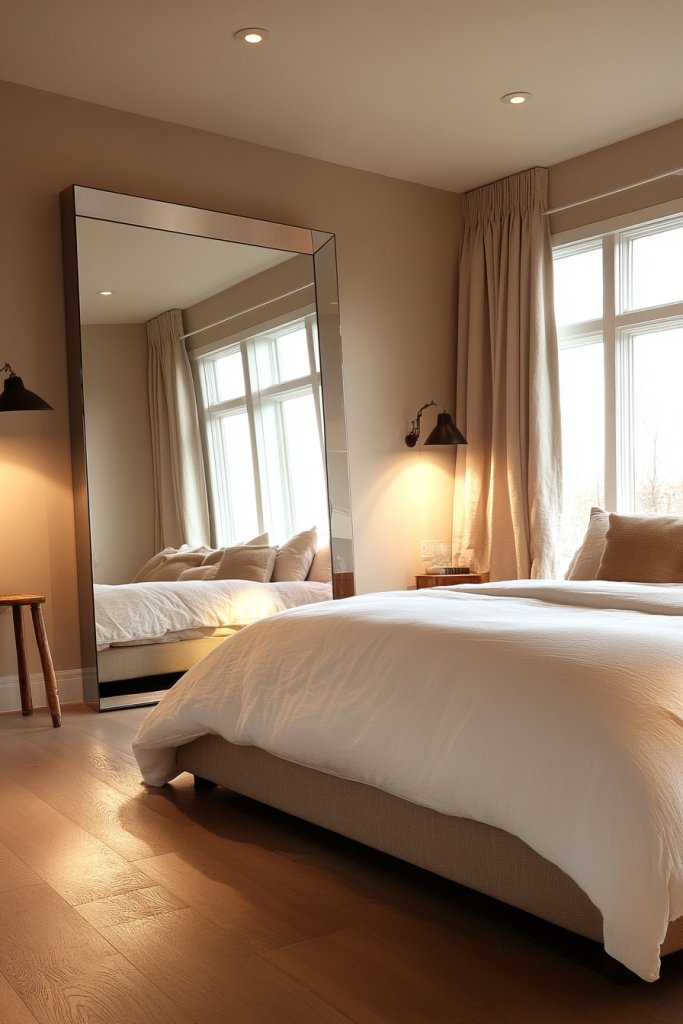
Feeling cramped or dim in your bedroom? Mirrors are your secret weapon for creating a sense of space and amplifying light. But misplacing them can cause energy to disperse or create unwanted reflections. Properly positioned, mirrors boost positivity and make your room feel larger and brighter. Ever wondered how to get the most from this trick?
Recommended Products to replicate this idea
| # | Preview | Product | |
|---|---|---|---|
| 1 |

|
Sweetcrispy 64"x21" Arched Full Length Mirror, Standing or Leaning Full Body Mirror with Aluminum... | Check Latest Price |
| # | Preview | Product | |
|---|---|---|---|
| 1 |

|
VETROVUE Round Wavy Mirror, 30 Inch Metal Frame Circle Mirror, Round Wall Mounted for Entryway,... | Check Latest Price |
Picture a large mirror hung to reflect natural light from a window, bouncing brightness into the room. Alternatively, a decorative mirror above a dresser adds depth and elegance, visually expanding the space. When placed correctly, the mirror captures a view of the room’s calming textures and shades, creating an illusion of more space. The result is an airy, luminous sanctuary that feels twice as big.
Opt for full-length or oversized mirrors in small rooms to create the illusion of space. Use decorative frames that match your decor style—wood, metal, or textured surrounds. Avoid placing mirrors directly facing the bed to prevent energy dispersal and restless sleep. For seasonal updates, move or angle mirrors to optimize light reflection. Keep them clean for maximum effect.
Choose a wall that benefits from natural light or open space. Mount your mirror securely, ensuring it’s level and at a height that captures your reflection comfortably. Experiment with angles to maximize light reflection and space perception. Pair mirrors with soft lighting to enhance their effect. Regularly clean and reposition as your decor evolves. This simple step can dramatically brighten and expand your bedroom.
Decorate the mirror’s frame to match your personal style—think textured wood, sleek metal, or painted accents. Use the mirror to reflect calming textiles or decorative elements (avoiding restricted items). Incorporate subtle lighting around the mirror for added glow. Keep reflections positive—avoid placing mirrors to reflect clutter or chaos. Small changes can make a big visual difference.
A well-placed mirror is a powerful tool for transforming your bedroom’s vibe. It boosts natural energy, making the space feel larger and more inviting. Trust your instincts—adjust placements until you feel the room’s harmony. With a simple mirror, you can create a brighter, more spacious sanctuary that energizes your daily life.
12. Incorporating Gentle Natural Scents for Relaxation

Ever notice how a room’s scent impacts your mood? Artificial fragrances can sometimes feel overwhelming or synthetic. Natural scents like lavender or chamomile evoke calm and help you unwind. Incorporating gentle aromas transforms your bedroom into a true sanctuary of peace and relaxation. Ready to breathe easier?
Imagine a soft diffuser releasing a mist of lavender, filling the room with a delicate, calming aroma. A small bowl of dried herbs or a scented candle (focusing on natural waxes) adds visual and sensory appeal. The air feels clean, and the scent lingers softly, inviting you to relax. The textures of natural materials—cotton, linen, and wool—complement the calming fragrance, creating a multisensory retreat.
Use essential oils in diffusers or add a few drops to natural cotton balls placed in discreet spots. Incorporate dried flowers or herbs into decorative jars or bowls. For seasonal variation, switch scents—peppermint for invigorating mornings, vanilla or jasmine for cozy evenings. Avoid synthetic air fresheners that can disrupt the calming vibe. The goal is subtle, natural aroma that soothes.
Choose high-quality essential oils known for their relaxing properties—lavender, chamomile, ylang-ylang. Use a diffuser or create your own by adding oils to a small dish of hot water or a cotton pad. Place diffusers or scent bowls in areas that don’t interfere with sleep or daily activity. Refresh scents regularly to maintain freshness. Keep the space well-ventilated to prevent overpowering fragrances.
Mix scents to craft your own calming blend—think a combination of lavender and chamomile. Use natural fabrics like linen pillowcases or curtains that absorb and diffuse aromas subtly. Incorporate natural elements like wood or stone decor, which also carry calming energies. Personalize your scent ritual to evoke feelings of safety and serenity.
Natural scents are a simple, non-invasive way to enhance your bedroom’s energy. They help create a relaxing environment that encourages restful sleep and emotional balance. Trust your nose—find the aromas that resonate most deeply with you. Small, thoughtful scent choices can make your bedroom feel like a true sanctuary of calm.
13. Setting Up a Balanced Artwork Display
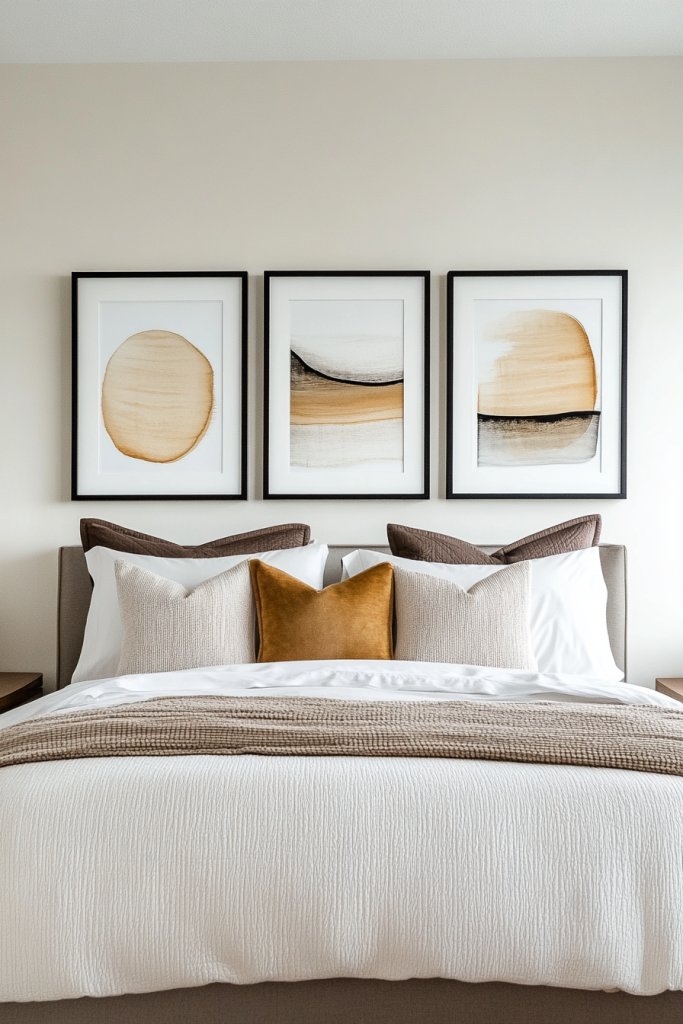
Feeling overwhelmed by cluttered walls or chaotic decor? Well-chosen artwork can bring harmony and focus to your bedroom. But overdoing it or selecting the wrong pieces can have the opposite effect. The secret is curating a balanced display that inspires calm and beauty without overstimulation. Ready to turn your walls into a source of peace?
Recommended Products to replicate this idea
| # | Preview | Product | |
|---|---|---|---|
| 1 |

|
16 PCS Framed Eclectic Wall Art Decor, Modern Maximalist Home Gallery Wall Frame Set Prints for... | Check Latest Price |
| # | Preview | Product | |
|---|---|---|---|
| 1 |

|
KURUI 303Pcs Picture Hanging Kit, Picture Hangers Assorted Kit with Heavy Duty Picture Hanging... | Check Latest Price |
Picture a single large, calming abstract print above the bed, with complementary smaller pieces arranged symmetrically nearby. Soft, neutral tones dominate, with subtle textures adding depth. The artwork’s placement creates a focal point that anchors the room, guiding your eye and calming your mind. The overall aesthetic feels curated, tranquil, and inspiring.
Use a single statement piece for a minimalist look or a carefully balanced gallery wall with evenly spaced frames. Stick to calming themes—nature, abstract forms, or gentle landscapes—avoiding overly busy or stimulating images. For seasonal updates, rotate artwork or change framing to keep the display fresh. The key is harmony, not clutter.
Start by selecting artwork that evokes serenity—think soft colors and gentle themes. Hang larger pieces at eye level above the bed or seating area. Use symmetrical arrangements for a balanced look, or asymmetrical for a more dynamic feel—just keep it cohesive. Use picture-hanging tools that protect your walls and ensure level placement. Regularly dust and maintain the artwork to keep it looking its best.
Incorporate personal touches—like a favorite quote or a calming photograph—within your artwork display. Use frames that match your decor, from sleek black to rustic wood. Add subtle textured mats or backing for depth. Keep the display uncluttered, allowing each piece to breathe and contribute to the room’s harmony.
Thoughtfully curated art transforms walls from visual noise into a source of inspiration. It anchors your space and encourages mindfulness. Trust your taste—select pieces that evoke peace and resonate with your soul. A balanced artwork display is one of the easiest ways to elevate your bedroom’s energy.
14. Using Soft, Textured Bedding for Comfort and Serenity

Ever slip into a bed that feels stiff or flat, leaving you restless? Soft, textured bedding invites comfort and calm, making your bed a true retreat. Comfort isn’t just about the mattress—your linens and throws set the mood. Imagine sinking into plush layers that cocoon you in serenity.
Recommended Products to replicate this idea
| # | Preview | Product | |
|---|---|---|---|
| 1 |

|
Bedsure Comforter Duvet Insert - Quilted Comforters Queen Size, All Season Duvet, Down... | Check Latest Price |
| # | Preview | Product | |
|---|---|---|---|
| 1 |

|
Bedsure GentleSoft White Throw Blanket for Couch - Cozy Blanket for Women, Cute Fleece Throws for... | Check Latest Price |
Picture a bed topped with a fluffy duvet in muted neutral shades, layered with a chunky knit throw and silky pillowcases. The textures invite touch, with tactile contrasts adding depth and warmth. Soft lighting highlights the plush fabrics, creating a cozy glow. The overall effect is an irresistible sanctuary of comfort and calm.
Choose high-quality fabrics like linen, cotton, or bamboo for breathability and softness. Layer different textures—smooth silk, chunky knits, and velvets—for visual interest. Seasonal swaps, like adding a faux fur throw in winter or a light cotton sheet in summer, keep it fresh. Keep color palettes calming—think pastels, creams, and muted earth tones.
Invest in high-thread-count sheets and a plush duvet or comforter. Incorporate textured throws and decorative pillows (if not restricted), mixing fabrics and patterns within your chosen color scheme. Regularly wash and fluff the bedding to keep textures inviting. Avoid synthetic fabrics that trap heat or feel rough. Layer your bed thoughtfully to maximize comfort.
Add a few tactile accessories—like a velvet cushion or a faux fur pillow—within your decor scheme. Use throws in different textures to switch up the feel seasonally. Personalize with embroidered or patterned textiles that evoke your style. Keep the bedding well maintained to preserve softness and texture.
Soft, textured bedding transforms your sleeping space into a soothing haven. It encourages relaxation and improves sleep quality. Trust in the power of tactile comfort—small changes create big comfort. Your bedroom should feel like a continuous hug at the end of each day.
15. Arranging Furniture for Flow and Accessibility
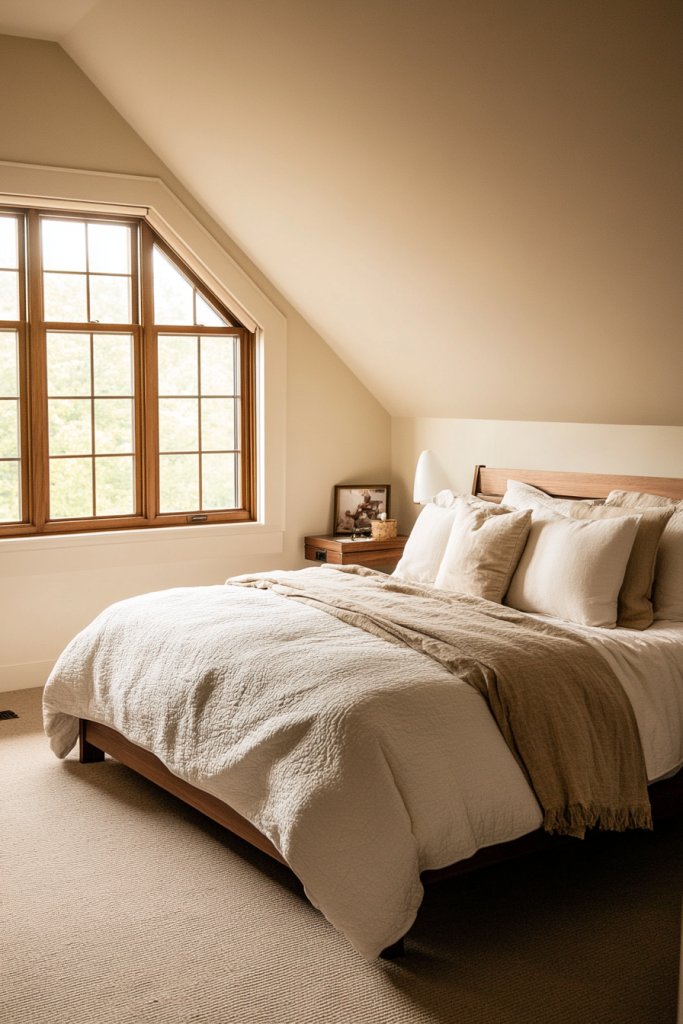
Is your bedroom a maze of furniture that makes you want to hide? Poorly arranged furniture blocks energy flow and hampers accessibility. A well-thought-out layout creates a sense of ease and harmony. Imagine moving around effortlessly and feeling energized instead of cramped.
Recommended Products to replicate this idea
| # | Preview | Product | |
|---|---|---|---|
| 1 |

|
NEW JETO Metal Bed Frame,Queen Size Bed Frame with Storage Space,Heavy Duty Sturdy Mattress... | Check Latest Price |
| # | Preview | Product | |
|---|---|---|---|
| 1 |

|
Sakugi Storage Shelves - 5 Tier Shelf Organizer, Heavy Duty Garage Shelving Unit with Leveling... | Check Latest Price |
Visualize a room with enough space between furniture pieces—your bed has clear walking paths, and dressers are within easy reach. Sharp corners face away from the bed, avoiding accidental bumps. The layout feels open yet cozy, with enough room for movement and daily routines. The space looks inviting and balanced, not cluttered or awkward.
In small rooms, opt for multi-functional or space-saving furniture—think beds with built-in drawers or fold-away desks. For larger spaces, create zones—sleeping, dressing, relaxing—using furniture placement. Avoid positioning furniture directly in pathways or blocking natural light sources. Seasonal or stylistic tweaks might involve swapping furniture for slimmer profiles or modular pieces.
Begin by measuring your room and furniture. Arrange your bed so that there’s at least 24 inches of clearance on either side. Keep pathways clear of clutter and avoid placing bulky furniture in high-traffic areas. Use furniture with rounded edges or soft lines to prevent sharp corners facing your sleeping area. Regularly reassess your layout to optimize flow and comfort. Small rearrangements can dramatically improve energy movement.
Incorporate movable or modular furniture to adapt to your needs. Add soft, spacious rugs to define zones and add warmth. Use decorative, yet functional, storage solutions that keep clutter out of sight and within reach. Personalize your space with favorite colors or textures, but keep the flow open and inviting.
Thoughtful furniture placement transforms your bedroom into a masterpiece of flow and function. It’s about creating a space that feels natural and effortless. Trust your judgment—small tweaks can lead to big improvements. A well-arranged room energizes your daily routine and promotes well-being.
16. Positioning Charging Stations Away from the Bed for Restful Boundaries
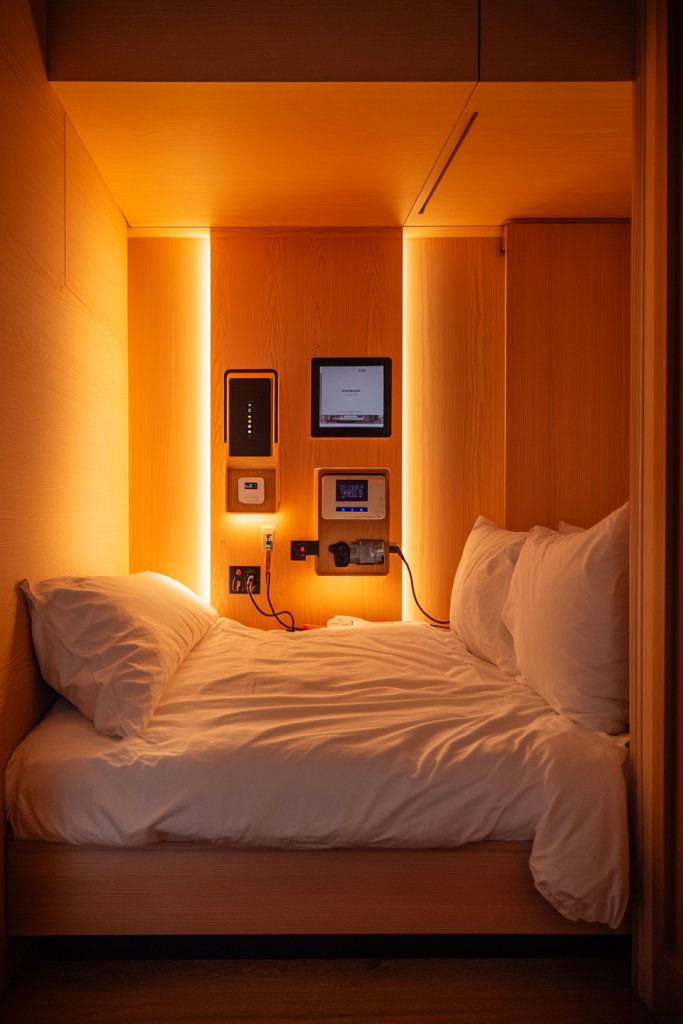
Are electronic devices invading your sleep space, making it hard to disconnect? Having chargers and gadgets too close can lead to electromagnetic interference and restless nights. Creating a designated charging zone away from your bed establishes healthy boundaries. Think of it as giving your sleep environment a clean break from digital distractions.
Picture a sleek charging station on a nearby dresser or in a corner, with cords neatly tucked away. Your phone rests on a dedicated pad, away from the bed, with a small basket for accessories. The space remains uncluttered, and your sleeping area is free from visible cables or tech clutter. It’s a peaceful sanctuary designed for rest, not screens.
Use stylish cord organizers or cable clips to keep things tidy. Opt for wireless charging pads or low-profile docks to minimize visual clutter. For multi-device households, create a shared charging station in a corner or on a shelf. Adjust placement seasonally or as your needs evolve, always prioritizing a tech-free zone near your sleep area.
Identify a spot in your room away from the bed—like a dresser or a dedicated shelf—where devices can be charged safely. Use cable organizers or decorative boxes to hide wires. Establish a habit of plugging devices in at least 30 minutes before bed, then leaving them outside the sleeping zone. Regularly check and tidy cords to prevent tangles and visual clutter. This boundary supports restful sleep and reduces electromagnetic exposure.
Choose stylish or textured holders that complement your decor—think woven baskets or minimalist trays. Incorporate a small clock or a calming visual cue to signal bedtime, further reinforcing boundaries. Use natural materials and neutral colors for a seamless look. This setup turns charging into a mindful, organized routine.
Establishing a tech-free zone in your bedroom fosters better sleep and mental clarity. It’s a simple step that significantly impacts your nightly rest. Trust that small changes—like a dedicated charging station—can improve your overall well-being. Your bedroom becomes a true retreat, free from digital distractions.
17. Creating a Personal Sanctuary with Meaningful Decor
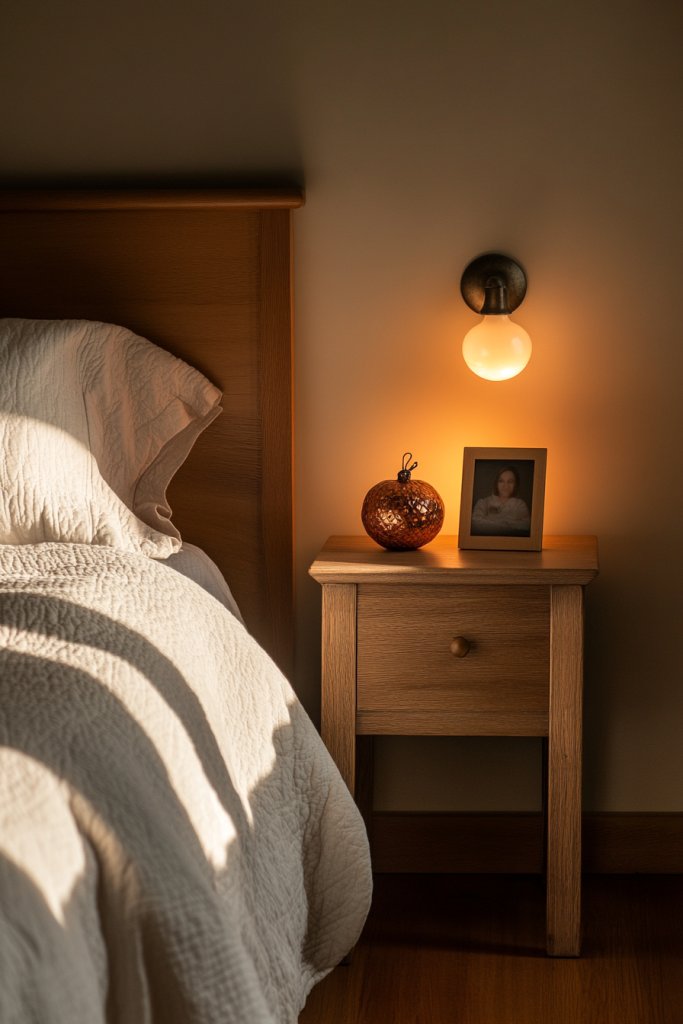
Feeling like your bedroom lacks personal touch or emotional resonance? Infusing your space with meaningful decor makes it truly yours. It encourages positive feelings and emotional safety, transforming the room into a sanctuary. Imagine waking up surrounded by objects that inspire and comfort you daily.
Recommended Products to replicate this idea
| # | Preview | Product | |
|---|---|---|---|
| 1 |

|
Donald J. Trump Photograph - Historical Artwork - US President Portrait - (8" x 10") - Semi-Gloss | Check Latest Price |
| # | Preview | Product | |
|---|---|---|---|
| 1 |

|
Fenmzee Bedside Table Lamp for Bedroom - 3 Way Dimmable Touch Lamp USB C Charging Ports and AC... | Check Latest Price |
Visualize a corner with a cherished object—perhaps a handcrafted sculpture or a photo in a special frame—placed with intention. Textiles like a favorite blanket or a meaningful pillow add tactile comfort. The room feels layered with stories and significance, creating a sanctuary that reflects your personality. The overall vibe is warm, inviting, and uniquely yours.
Choose decor that resonates emotionally—handmade items, souvenirs, or heirlooms—while keeping the space uncluttered. Rotate or refresh items seasonally to keep the energy vibrant. Incorporate symbols or objects that evoke positive memories or intentions. For smaller spaces, focus on a few key pieces that carry deep personal meaning.
Select objects and decor that inspire joy or calmness—avoid clutter or overly busy arrangements. Place these items thoughtfully on shelves, bedside tables, or wall-mounted displays (if allowed). Use lighting to highlight meaningful decor, creating focal points. Regularly reassess your collection, removing items that no longer serve your emotional well-being. The goal is a harmonious, heartfelt space.
Add personal touches like a handwritten note or a small craft that symbolizes your goals. Use textiles or decorative accents that evoke your favorite memories or aspirations. Incorporate calming colors and textures that make you feel safe and nurtured. Keep the overall environment simple yet emotionally rich.
Your bedroom should be a sanctuary that nurtures your soul. When you surround yourself with meaningful decor, you reinforce your intentions and wellbeing daily. Trust that personal touches turn a house into a home and a bedroom into a refuge. Creating your sacred space is a powerful act of self-care.
18. Maintaining a Consistent, Harmonious Layout for Long-Term Balance
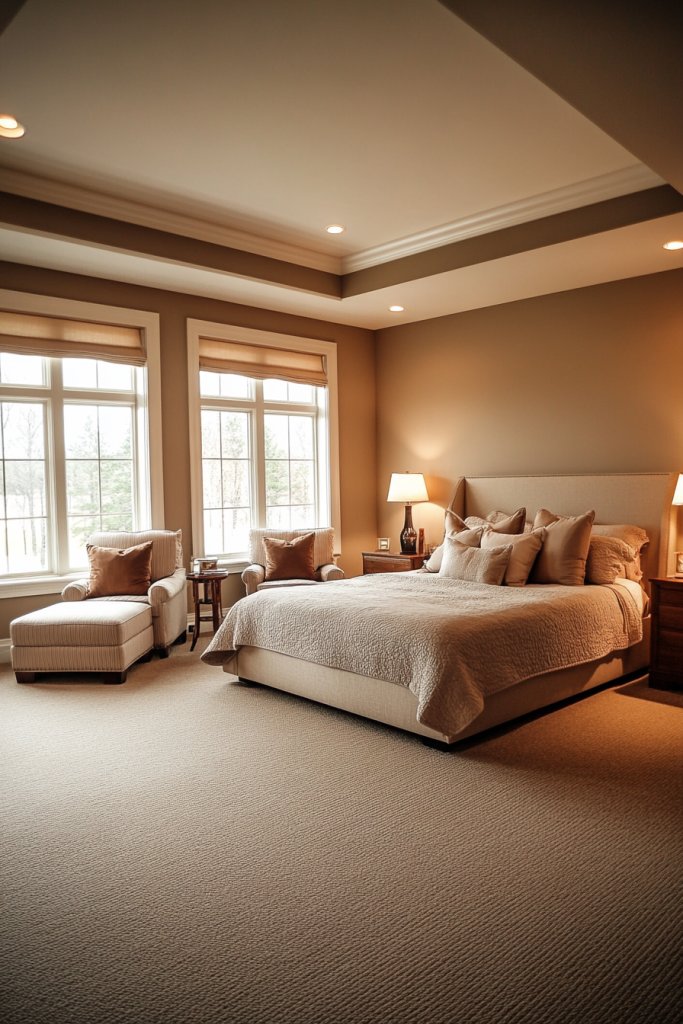
Is your bedroom feeling out of sync despite your best efforts? Consistency in layout and decor nurtures long-term harmony and peace of mind. When your space evolves naturally over time, it sustains positive energy and avoids chaos. Think of it as tending a living garden—regular care keeps everything balanced.
Recommended Products to replicate this idea
| # | Preview | Product | |
|---|---|---|---|
| 1 |

|
Sakugi Storage Shelves - 5 Tier Shelf Organizer, Heavy Duty Garage Shelving Unit with Leveling... | Check Latest Price |
| # | Preview | Product | |
|---|---|---|---|
| 1 |

|
Best Choice Products Ergonomic Full Size Adjustable Bed Frame, Electric Base w/Wireless Remote... | Check Latest Price |
Imagine periodically reassessing your furniture placement, switching out decor, or updating textiles to keep the room feeling fresh yet harmonious. The layout remains functional and beautiful, with each element supporting the overall energy. The room feels balanced, not static—an evolving sanctuary that adapts to your changing needs.
Set a routine to review your space every few months—rearranging furniture or swapping decor as seasons shift or your tastes evolve. Keep a consistent color palette and style theme to unify the space. Incorporate flexible furniture or modular pieces to accommodate growth or change. The key is intentionality and mindful updates.
Establish a simple routine: declutter, rearrange, and refresh your decor periodically. Keep a mental or physical checklist to assess the flow and harmony. Use neutral tones as a base, then introduce accent colors or textures in moderation. Document your layout with photos, so you can compare and refine over time. Consistency creates a stable, peaceful environment.
Celebrate your progress by adding new personal touches that reflect your growth—like new artwork, textiles, or functional decor. Keep a journal of your layout changes to track what works best. When you feel your space is in harmony, it supports your mental and emotional resilience. Small, regular adjustments keep your sanctuary vibrant.
Long-term balance in your bedroom nurtures your overall well-being. It’s about creating a space that evolves with you, supporting your journey. Trust that consistency and mindfulness build a sanctuary that sustains happiness and harmony. Your bedroom is a reflection of your inner peace—maintain it wisely.
Conclusion
These diverse feng shui bedroom layout ideas offer practical solutions and creative touches to elevate your personal sanctuary. By experimenting with these concepts, you can create a space that not only looks beautiful but also fosters peace and vitality. Don’t hesitate to try them out—your ideal, harmonious bedroom is just a few mindful adjustments away. Embrace the power of good energy and make your bedroom a true reflection of balance and serenity!
Last update on 2025-09-21 / Affiliate links / Images from Amazon Product Advertising API
Leave a Reply